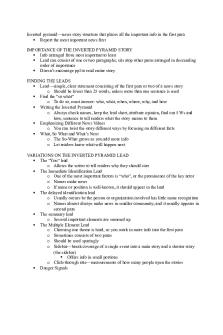FOOD Pyramid PDF

| Title | FOOD Pyramid |
|---|---|
| Course | Business English |
| Institution | Università degli Studi di Bari Aldo Moro |
| Pages | 2 |
| File Size | 150.2 KB |
| File Type | |
| Total Downloads | 1 |
| Total Views | 139 |
Summary
the food pyramid, simple explanation...
Description
FOOD PYRAMID https://www.youtube.com/watch?v=2H_jCO3H4Vo
Healthy Eating Pyramid
Generations of Americans are accustomed to the food pyramid design, and it’s not going away Consumers can think of the Healthy Eating Pyramid as a grocery list:
Vegetables, fruits, whole grains, healthy oils, and healthy proteins like nuts, beans, fish, and chicken should make it into the shopping cart every week, along with a little yogurt or other dairy foods if desired.
The Healthy Eating Pyramid also addresses other aspects of a healthy lifestyle—exercise, weight control, vitamin D, and multivitamin supplements, and moderation in alcohol for people who drink—so it’s a useful tool for health professionals and health educators.
The Food Pyramid
The Food Pyramid is a visual representation of how different foods and drinks contribute towards a healthy balanced diet. The Food Pyramid allows individuals the flexibility to choose foods and drinks from each shelf depending on their food preferences. It organises foods and drinks into 5 main shelves, starting from the most important shelf on the bottom.
Shelf 1: Wholemeal Cereals and Breads, Potatoes, Pasta and Rice (3–5 servings a day, up to 7 for teenage boys and men age 19–50). Wholemeal and wholegrain cereals are best. Enjoy at each meal.
Shelf 2: Vegetables, Salad and Fruit (at least 5 to 7 servings a day). Base your meals on these and enjoy a variety of colours. More is better. Limit fruit juice to unsweetened, once a day.
Shelf 3: Milk, Yogurt and Cheese (3 servings a day and 5 from the age of 9 to 18) Choose reduced-fat or low-fat varieties. Choose low fat milk and yogurt more often than cheese. Enjoy cheese in small amounts.
Shelf 4: Meat, Poultry, Fish, Eggs, Beans and Nuts (2 servings a day) Choose lean meat, poultry (without skin) and fish. Eat oily fish up to twice a week. Choose eggs, beans and nuts. Limit processed salty meats such as sausages, bacon and ham.
Shelf 5: Fats and Oils (In very small amounts) Use as little as possible. Choose mono or polyunsaturated reduced fat. Choose olive, sunflower or corn oils. Limit mayonnaise and salad dressings as they also contain oil. Always cook with as little fat or oil as possible – grilling, oven-baking, steaming, boiling or stir-frying.
Top Shelf: The revised Food Pyramid separates the Top Shelf from the rest of the pyramid. The Top Shelf includes foods and drinks high in fat, sugar and salt. These are not needed for good health and should not be consumed every day. Very small amounts once or twice a week maximum is sufficient....
Similar Free PDFs

FOOD Pyramid
- 2 Pages

Food Pyramid Word Worksheet
- 2 Pages

Assessment Two - Carroll\'s Pyramid
- 10 Pages

Population Pyramid - excel
- 2 Pages

Six.Domains.Leadership Pyramid
- 24 Pages

Chpt. 9 - Inverted pyramid
- 2 Pages

Chapter 9-inverted pyramid
- 6 Pages

Pyramid subcontracting and moral
- 23 Pages

Pyramid International Company
- 8 Pages

Food Packaging Notes - food science
- 12 Pages

Food Biochemistry and Food Processing
- 901 Pages
Popular Institutions
- Tinajero National High School - Annex
- Politeknik Caltex Riau
- Yokohama City University
- SGT University
- University of Al-Qadisiyah
- Divine Word College of Vigan
- Techniek College Rotterdam
- Universidade de Santiago
- Universiti Teknologi MARA Cawangan Johor Kampus Pasir Gudang
- Poltekkes Kemenkes Yogyakarta
- Baguio City National High School
- Colegio san marcos
- preparatoria uno
- Centro de Bachillerato Tecnológico Industrial y de Servicios No. 107
- Dalian Maritime University
- Quang Trung Secondary School
- Colegio Tecnológico en Informática
- Corporación Regional de Educación Superior
- Grupo CEDVA
- Dar Al Uloom University
- Centro de Estudios Preuniversitarios de la Universidad Nacional de Ingeniería
- 上智大学
- Aakash International School, Nuna Majara
- San Felipe Neri Catholic School
- Kang Chiao International School - New Taipei City
- Misamis Occidental National High School
- Institución Educativa Escuela Normal Juan Ladrilleros
- Kolehiyo ng Pantukan
- Batanes State College
- Instituto Continental
- Sekolah Menengah Kejuruan Kesehatan Kaltara (Tarakan)
- Colegio de La Inmaculada Concepcion - Cebu




